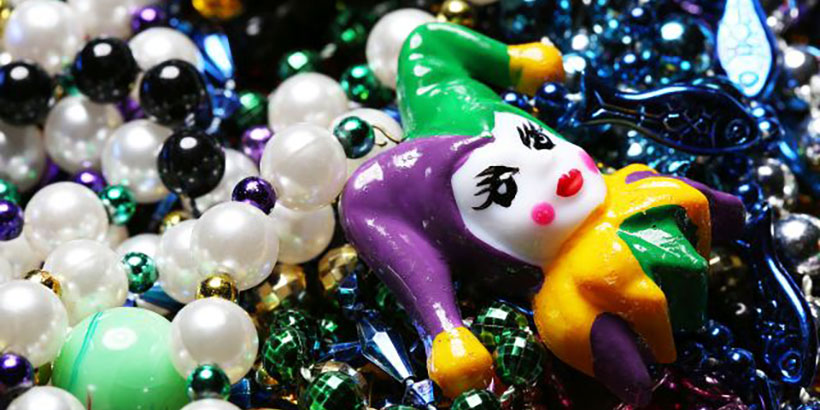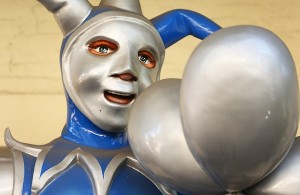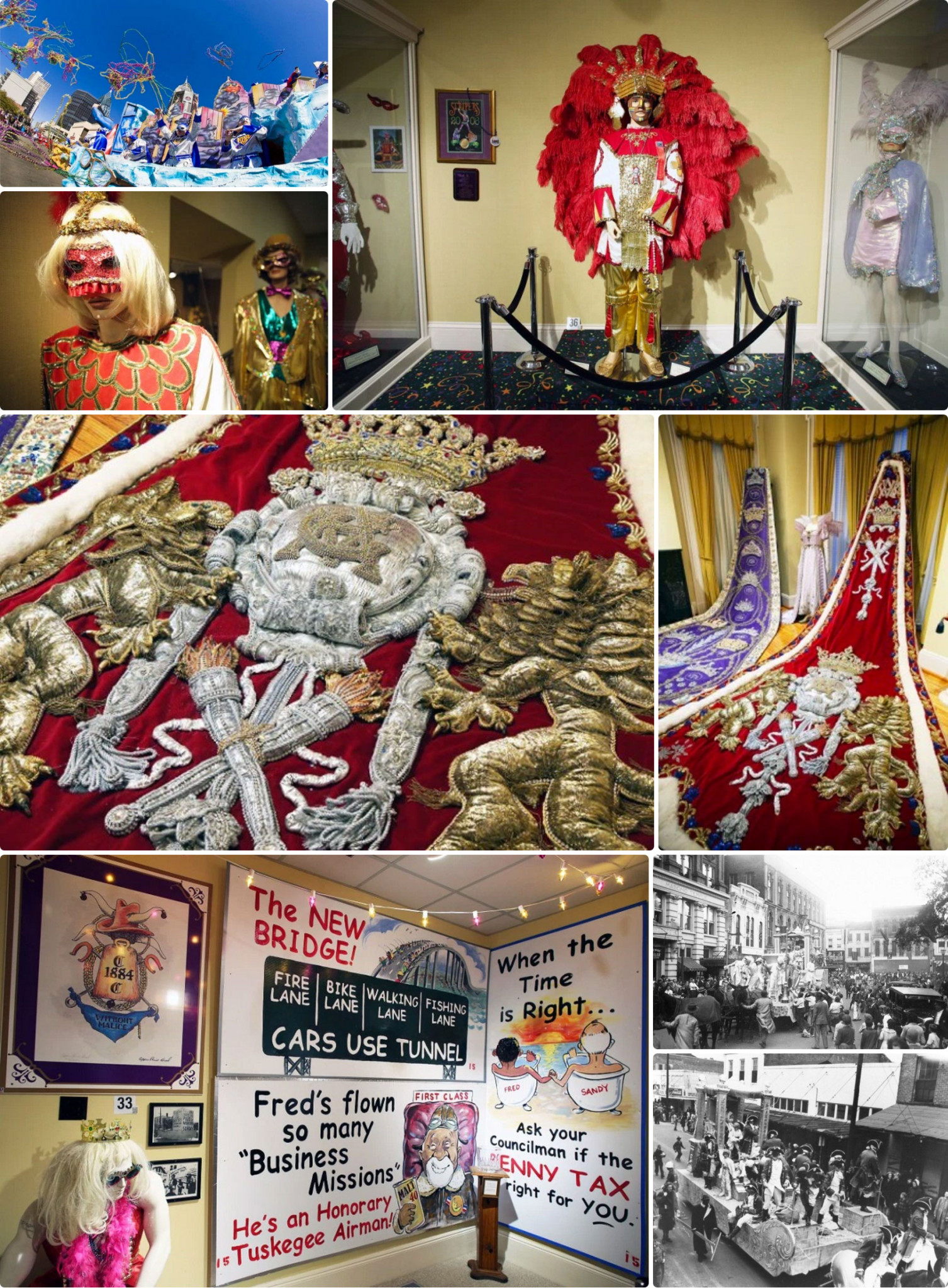
Mardi Gras goods are pictured Sunday, Jan. 10, 2016, in Mobile, Ala. (Mike Kittrell/Alabama NewsCenter)
By Kelli M. Dugan
In less than one week the crowds will be gone, the barricades will be loaded onto city trailers and the streets will show few signs – save for stray beads dangling from lofty live oak branches – that Mardi Gras 2016 attracted nearly one million people to downtown Mobile.
But even though Carnival season is set to vanish following Fat Tuesday’s climax faster than a MoonPie tossed from a parade float, true revelers know the real fun is only getting started.
With nearly two dozen parades scheduled to roll across the region between now and dusk on Mardi Gras Day – or almost as many as have thrilled crowds to date during the annual three-week celebration – locals and visitors alike are gearing up for what many consider the true main attraction of the birthplace of Mardi Gras.
Sunday marks Joe Cain Day, which longtime Mobile architect and historian L. Craig Roberts calls the “daylong celebration of the man credited with reviving Mardi Gras after the Civil War, Joseph Stillwell Cain.”
“Have you ever heard the expression ‘raise Cain’? It may originally come from Cain in the Bible, but we in Mobile have reason to claim the phrase, as we ‘raise Cain’ from the grave each Sunday before Mardi Gras,” Roberts wrote in “Mardi Gras in Mobile.”
Local lore contends that Cain, a former Confederate soldier, and six original members of the Tea Drinkers Society dressed as members of a Chickasaw war tribe – with their Confederate uniforms underneath – and paraded through the Union-occupied Mobile streets on Mardi Gras Day 1866.
Cain declared himself the fictional Chief Slacabamarinico and led the procession perched atop a coal cart the revelers named “Hickory” in homage to Andrew Jackson, Roberts writes, noting the Chickasaw personas were selected because the tribe “was never defeated in battle by French or American troops.”
The following year, “Ol’ Slac’ resurfaced on Mardi Gras Day in what Roberts described as a “tall plumed hat, a swallowtail coat with big brass buttons and red knee boots with spurs,” all while carrying a bass drum dubbing the troupe the “Lost Cause Minstrels.”
Cain’s contributions to Mardi Gras and all it entails – which are far too many to list – continued until his death in 1904, and 62 years later his body was exhumed, along with his wife’s, from Oddfellows Cemetery and relocated by city proclamation to Church Street Graveyard, Mobile’s oldest resting place.
The move was prompted by Julian Lee Rayford’s “Chasin’ the Devil Round a Stump,” published in 1962, in which he called Cain the “greatest man in the entire sweep of Mobile’s history.”

“No private citizen anywhere in the United States since 1600 has made more of an impact on a community – or left a more enduring impression of his personality. All the half a hundred great events of Mardi Gras since 1866 grew out of Joe Cain,” he wrote.
Of course, Rayford’s reverence for Cain extended far beyond his prose, and on the Sunday preceding Mardi Gras 1966 – the very day Cain’s body was re-interred on Church Street – he launched a jazz funeral procession featuring Mobile’s storied Excelsior Band.
“The procession began at the foot of Government Street and proceded fourteen blocks to the Church Street Graveyard…There the city would provide a jazz band at one side of the graveyard and a rock band at the other – yes, in the graveyard! Families were known to erect cabanas over their family members’ graves and have cocktails and brunch on top of the deceased,” Roberts writes in “Mardi Gras in Mobile.”
According to Roberts, the annual procession honoring Cain swelled to 30,000 revelers within 10 years and became known as the People’s Parade, led by Rayford himself as Chief Slacabamarinico. That mantle – headdress and all – was later taken up by J.B. “Red” Foster, and today the honor falls to local minister and author Bennett Wayne Dean Sr.
Unlike many other facets of Carnival’s more than 300-year history in Mobile, Joe Cain Day, often called the People’s Celebration, is in no way tied to the storied mystic societies or royal courts. And because the People’s Parade long ago outgrew its modest Church Street Graveyard beginnings, as many as 150,000 revelers now crowd the streets each Joe Cain Day to watch it snake along the 2.5-mile Route A through the heart of downtown.
The cemetery still plays a pivotal role in the annual celebration, and Roberts hits the following high points in “Mardi Gras in Mobile” for those unable to make the trek in person:
• Joe Cain’s Merry Widows – 16 total, dressed in full 19th-century black funeral attire with full black veils – arrive by bus at the Church Street Graveyard at 11:25 a.m.
• The Widows’ escorts are dressed in costume de rigueur, or white tie and tails.
• The Widows wail and often feign fainting upon entering the graveyard.
• Only the Widows and Mobile’s Excelsior Band are allowed inside the cemetery.
• The band plays “funeral” jazz while the Widows scream at each other and hurl accusations at one another regarding the manner in which Cain met his demise.
• Onlookers are permitted to perch atop the graveyard’s walls and, if they’re lucky, might receive a black rose from a Widow once the wailing gives way to frivolity.
• The Widows then board their bus bound for Cain’s original Oakleigh Historic District Home on Augusta Street, where the owner has a habit of inviting them in for cocktails.
• At 12:20 p.m., the Widows head downtown, disperse and distribute their telltale black beads to passersby.
• The People’s Parade rolls at 2:30 p.m., and is the longest of the three-week season.
• The Merry Mistresses of Joe Cain, dressed in fire-engine red 19th-century funeral attire with heavy veiling, lead the parade and later in the day make their way to the Church Street Graveyard.
Don’t miss out! Subscribe today to have Alabama’s leading headlines delivered to your inbox.
